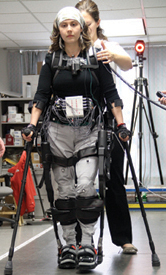With some assistance, people with different levels of spinal cord injury are able to walk using the exoskeleton

'I felt very stable and was excited to be able to walk on my own two feet. If I can use this device with my high level of injury, it opens the technology up to a very large population.'– Michael Rhode, who was injured while on ski patrol and also took part in the Ekso study.
A love of nature and adventure propelled graphic designer and dancer Laurie Kammer up a tall tree in June 2011. “A friend and I were fooling around, having fun,” she says. “We climbed a ladder up to a treehouse." There had been a bad storm and everything was wet and soggy. A board collapsed and Kammer fell backward about 15 feet.
"When I hit the ground I saw a purple flash of light," she recalls. "I couldn’t move my legs and had an instant realization that I’d never be able to dance again.”
Kammer, now 29, fractured her spine and is paralyzed from the waist down. She spent time in rehabilitation, where she cried when she looked down at her motionless feet, unable to feel them or make them move. In rehab, she learned new ways of doing things and gradually came to accept the fact she would not walk again.
In October 2011, just four months after her fall, however, Kammer came as close to walking as is possible for someone who’s paralyzed. She was one of six individuals selected to participate in a pilot study at New Jersey’s Kessler Foundation involving Ekso, a battery-powered robotic exoskeleton. Ekso is strapped on over a user’s clothing and enables standing and walking. It’s much less cumbersome than the bionic suit of armor in the movie “Iron Man,” but what it does is even more magical: it enables people with spinal cord injuries to stand and walk.
The principal investigator of the study is Gail Forrest, assistant director of the Human Performance and Engineering Laboratory at Kessler Foundation and an assistant professor of physical medicine and rehabilitation at New Jersey Medical School (NJMS). Her research focuses on the effect of walking and standing on the health issues of those who are paralyzed.
“Being confined to a wheelchair affects the human body in many ways,” Forrest explains. “You can’t move and have limited use of your muscles. Heart rate, circulation, bowel, bladder and respiratory function are affected. In this study, we are evaluating the impact of mobility on serious health issues. Do walking and standing improve bone and muscle strength, circulation, cardiovascular and respiratory function? These are important questions we want to answer.”
The device’s manufacturer, California-based Ekso Bionics, initially approached Steven Kirshblum, medical director and director of spinal cord injury rehabilitation at Kessler Institute for Rehabilitation, a few years ago. At the time, Ekso was establishing a consortium of organizations to study the practical applications of the device. Kessler is part of a core group of 10 centers to partner with the company to develop protocols and examine the effects of walking with Ekso on the health of people with spinal cord injury.
“As a charter member of this consortium, we have the chance to enhance mobility for people with spinal cord injury, as well as enhance the science of what’s going on in the field. It’s very exciting,” says Kirshblum, who is also a professor of physical medicine and rehabilitation medicine at NJMS.

Forrest calls this first group of six patients to use the device at Kessler “test pilots.” They underwent several sessions of training. Kammer was the first person at Kessler to use the Ekso robot. She was strapped into it while it was attached by a pulley to a track in the ceiling. One or two therapists were there to guide her for her trial run.
With four motors and 15 sensors, Ekso’s aim is to simulate human gait. For the first walk, patients use a walker. After they’ve become accustomed to Ekso they move on to bilateral canes. “While in the robotic exoskeleton patients learn subtle positional shifts: leaning and transfer of weight,” explains Forrest. “The robot is sensitive to these signals.”
Taking those first steps, “I was in a state of awe,” says Kammer. “I just kept thinking, ‘We are doing something so important right now.’” Over a five-day period, Kammer stood and walked, becoming more proficient each time out. Five other patients also successfully stood and walked with the device and the researchers recorded their walking speed and distance.
Among them were Seabro Celso, who was paralyzed in a motorcycle accident, and Michael Rhode, who was injured while on ski patrol. Rhode had the highest level of injury of all participants: C-6 C-7 quadriplegia. With limited hand and trunk function, he feared he’d be unsuccessful, but was able to take 520 steps during his first session.“I felt very stable and was excited to be able to walk on my own two feet,” Rhode says. “If I can use this device with my high level of injury, it opens the technology up to a very large population.”
In September 2012, Forrest presented preliminary research findings from the study at the annual meeting of the Academy of Spinal Cord Injury Professionals. “Our initial testing clearly showed that with some assistance, patients with different levels of spinal cord injury are able to walk using the exoskeleton,” she states. Metabolic and cardiovascular responses were evidenced by increases in oxygen consumption, ventilation and heart rate. These increases occurred with changes from resting to a standing position and increased further with changes from standing to walking.
The research team also found increased muscle firing in the lower leg muscles during Ekso-assisted walking. More detailed research is also needed to evaluate the potential health benefits of this muscle activity, says the researcher. She plans to launch a new phase of the study shortly.
“The psychological benefits to paraplegics of standing up and walking are incalculable,” says Forrest. “The patients in the study were thrilled to be able to stand up and take steps.”
This article was orginally published in UMDNJ Magazine Spring/Summer 2013.